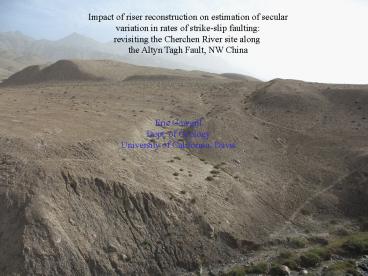Impact of riser reconstruction on estimation of secular - PowerPoint PPT Presentation
1 / 16
Title:
Impact of riser reconstruction on estimation of secular
Description:
Impact of riser reconstruction on estimation of secular ... comparison of riser offset with inset channel width. similarity of riser and tread displacements ... – PowerPoint PPT presentation
Number of Views:79
Avg rating:3.0/5.0
Title: Impact of riser reconstruction on estimation of secular
1
Impact of riser reconstruction on estimation of
secular variation in rates of strike-slip
faulting revisiting the Cherchen River site
along the Altyn Tagh Fault, NW China
Eric Cowgill Dept. of Geology University of
California, Davis
2
(No Transcript)
3
Purposes of study
- Reduce epistemic uncertainties
- comparison of riser offset with inset channel
width - similarity of riser and tread displacements
- morphological analysis of scarp profile
- riser deflection in plan view
- diachroneity of terrace abandonment
- whether riser crests or bases yield slip vector
4
- Present geomorphic observations
- determine which terrace age most closely
approximates true riser age
5
(No Transcript)
6
- Fluvial terrace risers erosional escarpments
that separate two stream terraces of different
age and elevation. - Fill terraces- form during aggradation by
deposition of alluvium - Strath terraces- form during incision, cut into
bedrock
7
(No Transcript)
8
- Treads
- gently sloping surfaces separated by steep
terrace risers, formed during incision
- Upper-terrace reconstruction-
- riser offset combined with age of upper tread
- assumes flow over lower tread is too weak to
erode riser - displacement begins upon initiation of
upper-tread incision - error in this reconstrucion will result in a
slip-rate that is too slow
9
- Lower-terrace reconstruction-
- riser offset combined with age of lower tread
- typically used for strath terraces, assuming all
displacement is removed by lateral erosion and
scarp refreshment - displacement is accumulated only after lower
terrace is abandoned - error will result in slip-rates that are too fast
10
(No Transcript)
11
Ambiguity in terrace reconstruction
- Previous studies focused on the type of terrace
offset - Strath
- Fill
12
- Ambiguity in terrace reconstruction
- This study
- age refers to portions of the tread extending
several hundred meters up and downstream from
fault trace. - age refers only to the time at which the tread
was abandoned due to renewed incision - this definition is thus independent upon the type
of terrace present
13
Slip rate reconstruction
- Determination of two records
- displacement record beginning with accumulation
of offset - age of terrace when tread is abandoned and new
lower terrace if formed. - Both must begin simultaneously
14
Geomorphic indices for identification of upper
vs. lower terrace reconstruction
- Reduce epistemic uncertainties
- comparison of riser offset with inset channel
width - similarity of riser and tread displacements
- morphological analysis of scarp profile
- riser deflection in plan view
- diachroneity of terrace abandonment
- whether riser crests or bases yield slip vector
15
(No Transcript)
16
Conclusion
- Lower-terrace reconstruction yields a maximum
rate by assuming that stream flow on the lower
tread completely refreshes the riser, thus offset
does not begin untill lower surface abandonment - Upper-terrace reconstruction provides a minimum
rate by assuming that riser offset starts
accumulating as soon al the riser forms - the 6 Indices outlined are vitally important to
determining which reconstruction to assume































